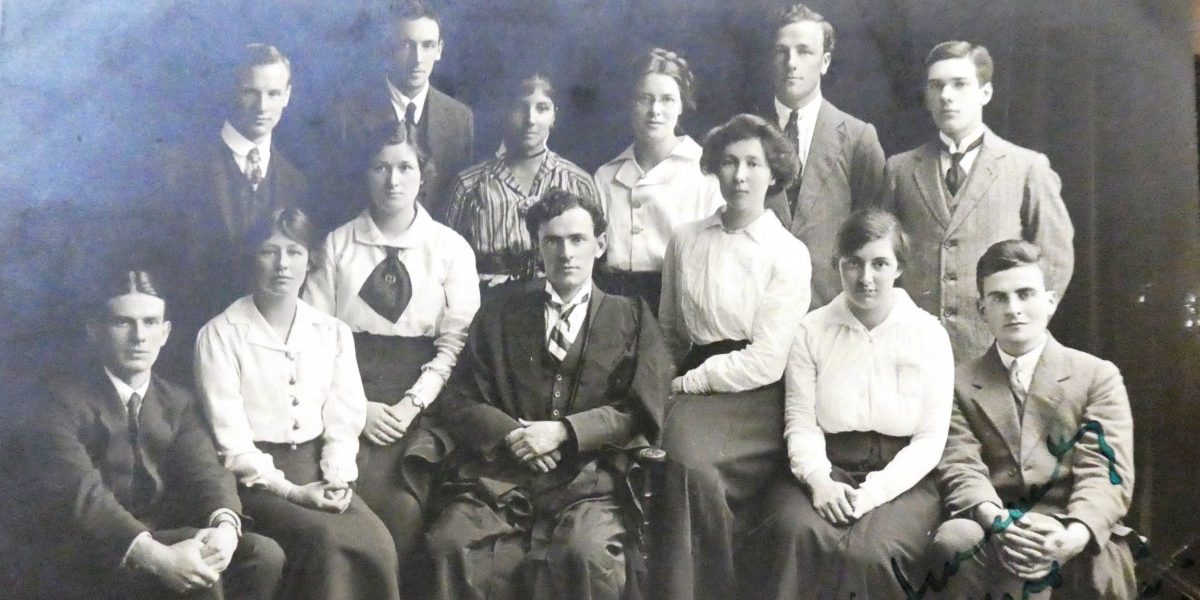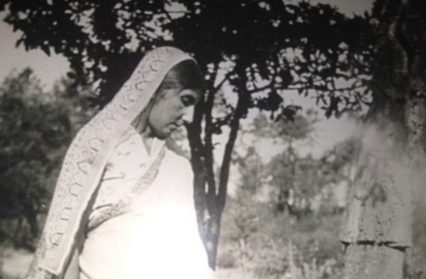Devika Karnad and Marine Furet take a look at the life of Dorothy ‘Dorf’ Bonarjee, who was awarded one of Wales’ most prestigious cultural prizes in February 1914, and consider the poet’s contribution to Wales’ multicultural heritage.
When Dorothy Bonarjee, aged 19, became the first Indian and the first woman to win the Bardic chair at the 1914 Eisteddfod of the University College of Wales, now the University of Aberystwyth, her father declared: ‘If India has given birth to a poet, Wales has educated her.’ After her victory, the Cambria Daily Leader hailed the ‘remarkable scenes’ of a ‘Hindu lady chaired’. The Indian press also praised her feat. Who can claim Dorothy Bonarjee – or ‘Dorf’ as she was known to some? Is it India, is it Wales? Not, it seems, her family, who unsuccessfully attempted to bring her back into the straight and narrow after her illustrious academic path, which included becoming the first woman to complete an internal law degree at University College London. Nor her French husband, Paul Surtel, tersely dismissed – ‘Nothing is more wearing morally than a weak husband.’
From Rampur to London, and from Aberystwyth to the South of France, Bonarjee’s itinerary marks her out as singular. Facts in circulation about Dorothy Bonarjee owe much to Andrew Whitehead’s research and to her entry in the Dictionary of Welsh Biography by Beth R. Jenkins, which rightfully celebrate Bonarjee’s uniqueness as a woman of colour from the colonies overcoming stunning odds to make her mark on history. She is cast in her family’s archives as strongly individual, and eminently modern, leading a life that most Indian women, even today, might only fantasise about. A photograph of her with classmates at Aberystwyth, featured in an article by Whitehead on the Indian news website, The Wire, emphasises the many ways in which she stands out. It is not only her skin colour, marked by a darker tone of grey in this black and white photo, but the blouse she is wearing, striped in contrast to the staid whites of the women surrounding her; her hair pulled back in a markedly non-Edwardian style, and interestingly, her gaze, pointed slightly downward and to the camera’s left as opposed to all her classmates who watch us watching them with gazes directly pointed at the camera. This photograph, and these stories, emphasise Bonarjee’s uniqueness.

And yet, Bonarjee’s path is not as solitary as it seems. For one of us (Karnad), as an Indian literature student in Cardiff who is afforded the same privileges in India and feels the same affinity for Wales’ (post)colonial and Celtic identities as Bonarjee, this story presents an opportunity to shine a light on a lineage of Indian women who successfully created an environment of possibility and change in the late-nineteenth and early-twentieth century, breaking barriers that held back not only their fellow Indian women, but also British women, in avenues of education and literature. These Indian women indeed seized the opportunities their privileges afforded them and fought battles upon the turfs on which they remained fettered. Their successes cannot be celebrated, however, without acknowledging the disparities embedded within our identities as middle-class brown women from ‘the colonies’ (now ‘the developing world’) able to live in the imperial metropolis, while other Indian women, who remain haunting shadows in these tales of success, cannot.
When, after her schooling in London, Bonarjee made her decision to study at university, she chose not to continue studying in the capital city, which she found too ‘snobby’, and instead made her way to the margin off the centre, Aberystwyth in Wales. Her winning poem at the Eisteddfod, presented under the pseudonym ‘Shita’, was on an eminently Welsh topic: soldier Owain Lawgoch. Her attraction to the Welsh bards bespeaks her attraction to the older roots of Celtic culture, and yet her published poetry (examples of which are linked in her biographical entry) reflects her metropolitan education and influences, with its Victorian-inspired verse, often elegiac tone, and references to figures from antiquity like Diana and Menelaus. Not many of her poems betray her Indian roots either, except one that ominously describes her childhood as lying in a grave in a ‘dim woodland… all alone’. Dorothy Bonarjee’s writings thus reflect the hybridity of her education, both near the centre of power and yet in its margins, and her straddling of multiple cultural identities.
In creating work that showcases such diverse influences, particularly that of a Victorian sensibility, and finding success in Britain, Bonarjee finds herself in the company of female Indian literary icons like the poet Sarojini Naidu, ‘the Nightingale of India’, who was at the height of her fame at the same time as Bonarjee’s winning of the Eisteddfod, and Toru Dutt, who was not only a prodigious poet and translator ‘made much of in the literary circles of London’, but also one of the first Bengali girls to travel with her family across the ‘black waters’ to Europe. Bonarjee thus follows in these women’s footsteps both literally and symbolically. In her academic accomplishments too, Bonarjee is preceded by the likes of Cornelia Sorabji (the first woman to take the civil law exam in Oxford in 1890 and India’s first female advocate) and Kadambini Ganguly (India’s first practising female physician who was awarded the Triple Qualification of the Scottish medical colleges in 1893).
Contextualising Bonarjee’s win, however, goes beyond naming a few shining stars who have left a legacy for Indian women to celebrate today – it also involves underlining how these avenues were particularly available to Bonarjee, as well as to the women named above, in late-nineteenth to early-twentieth century India. The entry on Dorothy Bonarjee in the Dictionary of Welsh Biography notes her birth in 1894 in a Bengali Brahmin family of lawyers and landowners who converted to Christianity. Theorist Homi Bhabha has recounted the British colonial impetus to create an English-educated Indian elite intended to mediate imperial power which was (in)famously described by T.B. Macaulay in 1835 as being ‘Indian in blood and colour, but English in tastes, in opinions, in morals, in intellect’. The class of upper-caste landed gentry Bonarjee’s family belonged to embodied this elite position and gained the privileges this position helped accrue in nineteenth-century British India, including a relatively progressive attitude towards women’s issues.
Bonarjee’s parents had such a progressive outlook and advocated for the education of girls. Her mother was secretary of the Indian Women’s Education Association in London, and both mother and daughter participated in the British suffragette movement. In The Documentary Podcast’s episode on Bonarjee, Dr. Sumita Mukherjee, a researcher on Indian women’s involvement in the movement, remarks that the composition of this group was ‘quite elite’, and that it was ‘not a particularly politically radical thing for an Indian woman in Britain who [wanted] to do something with their time and socialise to engage with the suffrage movement’. The remarkable work of Indian women like the Bonarjees, alongside Sophia Duleep Singh, Madam Bhikaji Cama and Mrs. Lolita Roy, who were at the forefront of the Indian contingent of the suffragette movement, is thus framed by the ‘polite’ classes within which they conducted it.
Understanding the location from which Indian women in Britain participated in the suffragist movement gives us a glimpse into the official beginnings of an Indian feminist movement that was rooted in the milestones achieved by women like Bonarjee. This movement has in fact grappled with its particularly upper-class origins throughout the twentieth century, even as it consolidated its aims and picked its battles. In her book on the history of the Indian feminist movement, The History of Doing, Radha Kumar records that, as far back as the 1920s, when the first women’s conferences took place, there was an awareness of the disparities between the women who participated in its activities, and the less privileged women who were, in a sense, being ‘acted upon’. Kumar mentions an inaugural conference on educational reform held in 1926, where the organiser expressed her exasperation at its attendants’ inability to ‘think of… the education of the princess down to that of the sweeper’s daughter’. Recognising these fractures within India, and Bonarjee’s own location as an educated Brahmin woman from an influential family, reveals a shadowy, haunting present-absence in that photograph of Bonarjee with her classmates which symbolises Indian women’s accomplishments – that of the working-class, labouring woman in India (a home that Bonarjee never returns to) who did not benefit from the same opportunities.
By adding such nuances of caste, class and geography around the bold and bright strokes that Bonarjee leaves upon history, we arrive at an intersectional perspective on the radicality she brings to our readings of race, sex and imperialism in early-twentieth century Wales. Reclaiming Dorothy Bonarjee from a Welsh perspective may enable us to imagine a more diverse and multicultural British history, one exemplified by the ‘Making Britain’ archival project currently building a database of South Asian contributions to a British past and present. It is important, however, even as Bonarjee’s contribution to a Welsh multicultural heritage is fleshed out, to pay attention to the roots of her success that are embedded within Indian cultural politics. Only by acknowledging those privileges can we write a history of resistance ‘without appropriating from a position of power or occluding [marginalised] realities and discourses,’ as Tabish Khair phrases it. In doing so, we also add complexity to any simple reading of ‘resistance’ we might be in danger of undertaking too eagerly.
Header image: Dorothy Bonarjee in a Sari (Credit: Sheela Bonarjee).
Recommended for you: Wales Arts Review’s Flash Fiction collection featuring original works from Cynan Jones, Nigel Jarrett, Richard Gwyn and many more of Wales’ best literary talents.












